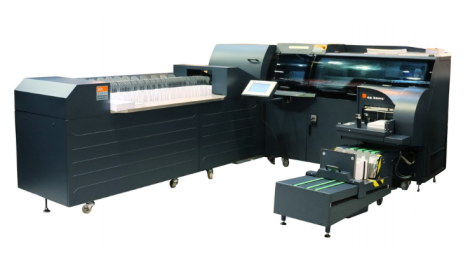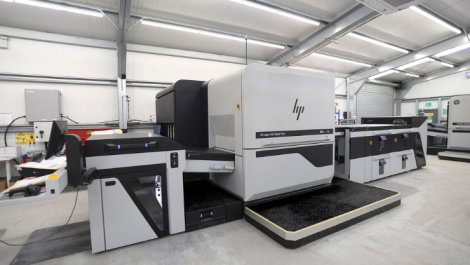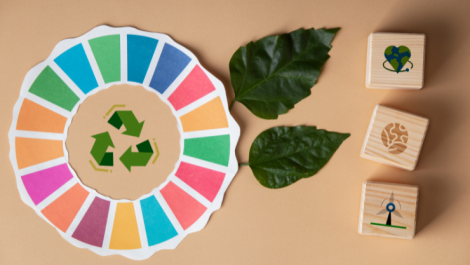Whether you’re an environmentalist by conviction or just cash-conscious, there are compelling reasons to adopt sustainable practices in your business. Michael Walker spoke to two printers to see how and why they did it.
The episode of Blue Planet II in which David Attenborough revealed some of the effects of plastic pollution on marine life may have had more effect on raising public awareness of the negative impacts mankind is having on the environment than any number of dry statistics about accelerating biodiversity loss, increasing incidence of extreme weather events or the gradual upward climb in parts per million of carbon dioxide in the atmosphere, but from an environmentalist’s point of view, anything that gets these issues pushed up the agenda is good news, so long as it leads to action.
What about from the printer’s point of view, though? Print is often viewed by a still largely uninformed public as a dirty industry that cuts down rainforests to print junk mail. Printers know that’s not true, though they don’t always say it loudly enough, or necessarily to the right people. But do we need to get religious about it to do something to reduce or offset the environmental impacts that we do make, or is there a compelling bottom-line business case that puts it in the no-brainer category?
Sustainability in Sussex
From its early days when it was known as Beacon Press, Uckfield-based Pureprint has grown to a 420-person business turning over £60 million with two sites in the East Sussex town, customer facilities in central London, a creative packaging studio in Hemel Hempstead and through the acquisition of Imprint, a 130-strong PoS and retail design agency in Newcastle.
Pureprint has been an HP Indigo house for around seven years, though it still keeps a fleet of four Heidelberg presses busy. Director Richard Owers says the company chose the HP liquid toner technology because ‘it didn’t compromise quality. It had to slot into what we were doing already, and bring extra things. Its flexibility in substrates at the time was unusual; you can’t tell creatives that they can only use this or that paper.’
Right back from 1990 the company has had a strong environmental ethos, which began when the daughter of Beacon Press owners Mark and Wendy Fairbrass returned from university. ‘Mark looked to address her environmental concerns but there was no blueprint. So he created the blueprint,’ says Mr Owers.
The model Mr Fairbrass devised, and which the company still follows years after his retirement, had three objectives: to minimise the impacts of its own processes; to influence and educate staff, customers and other stakeholders to spread the message; and to work in the print and paper sectors to share its thoughts and beliefs to influence the behaviour of the wider industry.
‘There was always a genuine desire to improve, and it’s still the case today,’ affirms Mr Owers. Back in the 1990s, this meant looking at reducing water consumption and dealing with hazardous film and plate processing chemistry. Today, it’s been extended from prepress and specific processes to making the entire business carbon neutral, a status it’s held since 2001. Mr Owers stresses that this is a voluntary act. ‘We only do it because we believe it’s the right thing. ISO14001 certification [a standard for environmental management] is a prerequisite for tendering, for example, but being carbon neutral wouldn’t be,’ he explains.
Being carbon neutral or carbon-balanced means paying to offset the carbon dioxide emissions related to the energy and materials use involved in running the business by investing in schemes that reduce carbon dioxide emissions elsewhere, preserve carbon “sinks” (typically areas of rainforest) or even work to increase carbon capture through planting new trees (reforestation/afforestation). ‘It is a cost to the business,’ confirms Mr Owers, adding that Pureprint has offset over 26,000 tonnes of carbon dioxide, which he says is equivalent to 100 million miles of air travel by one person. He also points out that for larger enterprises, their carbon footprint is a mandatory reporting requirement and is shown as a liability on the balance sheet.
Calculating the carbon footprint of a business can seem a daunting task at the outset but gets easier the longer you do it. Pureprint measures 29 environmental performance indicators each month at its Uckfield sites, covering resource use, waste and energy. ‘After 15 to 20 years it’s well-established, and not so difficult to do,’ says Mr Owers. This isn’t to say that it takes 15 years to get it working; Mr Owers explains that for Beacon Press owner Mark Fairbrass “sustainability” meant economic sustainability too so the company doesn’t pursue anything with a negative effect on the business. ‘All the best initiatives had a positive financial benefit, which was a surprise in the early days,’ he confirms.
Pureprint’s carbon balancing journey began with the now-defunct Paperlinx but continues with Denmaur, who provides carbon footprint information for the papers it supplies. This allows Pureprint to offer its customer the option to choose carbon-balanced products, while continuing to offset its own production activities. ‘Paper is the biggest carbon element of a job, so we can offer carbon balancing on paper. Some customers are definitely receptive,’ says Mr Owers.
Although Pureprint’s six HP Indigo presses (three SRA3 7800s, two B2 10000s and its 12000) don’t generate the same chemical waste as CtP plate processing, fount solution and so on from the litho machines, or any waste sheets, they do produce a stream of empty ink bottles, which are collected by environmental specialist J&G Environmental.
Spreading the word
The company has attracted attention over the years for its environmental efforts, including a Queen’s Award for sustainable development in 2003, and research amongst its customer base revealed that some 80% thought this ethos made a significant difference to their purchasing decisions.
‘That was a defining moment,’ says Mr Owers, though he qualifies, ‘It’s the least in the price, quality, service and sustainability balance but could tip a decision where the others are equal.’
He’s also keen to share the message and one way is to put a job’s environmental credentials on it somewhere. ‘It costs nothing to put a message on a bit of print. It’s commercial best practice, increases awareness, and can influence buyers – an easy win,’ he explains.
Pureprint has been a World Wildlife Fund for Nature member for more than 15 years. The WWF operates the Global Forest & Trade Network for responsible paper sourcing and in 2017 over 99% of the paper Pureprint used was recycled or FSC-certified; 100% of it was from “credibly certified” sources, says Mr Owers.
The company is also buying into the World Land Trust (WLT), a conservation charity that uses its funds to protect environmentally threatened areas. Its director of communications and development Dan Bradbury – who has a background in print and design for packaging – explains, ‘Our emphasis is on land as the most important part in conservation – we protect the land and the biodiversity in there. You could say “let’s protect a particular species” but it has to have somewhere to live.’ WLT projects are managed by local non-governmental organisations, providing opportunities that would not have existed otherwise.
WLT offers three carbon-balancing options for printers. The first is a choice of paper suppliers who support the charity, Antalis, Denmaur and Fedrigoni, who can offer carbon balanced papers such as Denmaur’s Revive recycled stock. The second is to carbon balance individual jobs via its website. An online calculator allows the printer to enter the job details and be given a carbon cost based on Defra figures to offset it. It also generates a logo and unique job number graphic which can be used in the job itself or otherwise kept for traceability and auditing purposes.
Mr Bradbury says this has been used on everything from teabag cartons to leaflets and magazines, which he sees as a great way of spreading the word, but is also used for some “huge” jobs by brands who don’t want to shout about it. ‘It helps printers to both have a positive impact and to offer something different,’ he says, adding that in his experience in packaging design, while there is always pressure to reduce material use, environmental impact and costs, this can only go so far while still meeting the product requirements and that the last option then is to carbon-balance.
The job-by-job carbon balancing option works well for long run litho jobs but doesn’t naturally suit the much more piecemeal nature of digital print, which leads to the third WLT option, which is to carbon balance the entire print company. Mr Bradbury emphasises that this doesn’t mean an overnight reinvention of the business but instead can be tackled step by step:
‘To lessen the impact of a business we measure, reduce, then offset,’ he explains. What’s measured is energy, waste and water, which can be done easily enough from utility bills. The reduction can take a number of forms, from investing in more environmentally friendly lighting equipment or switching to greener energy suppliers to tweaking processes both within the business and outside it. It’s not just about changing lightbulbs (though that’s a good start), some unexpected examples include adjusting the speed at which presses run to optimise water consumption and drying efficiency and even one large company reducing the speed at which the vessels shipping its supplies sail in order to reduce their energy consumption.
The offsetting part is then based on the remaining unavoidable carbon usage. The cost is around £15 per tonne of carbon dioxide equivalent; what that translates into for a printer depends very much on what they’ve got and what they do, but it’s not an all-or-nothing option. ‘We’re not asking anyone to jeopardise their business or reduce quality. Company sizes and approaches vary and we’re not asking for all of it at once,’ explains Mr Bradbury. ‘Printers can speak to us about their business and we can start with certain parts of it, energy, for example and build up from there.’
The carbon-balanced business option operates on a yearly basis that requires an annual audit to set the offset value, and Mr Bradbury acknowledges that perversely, he hopes that these audits will drive less income for WLT over time because that means that the printer is reducing its environmental impact. This typically means it’s saving money too, so that’s a double benefit.
Balanced in Bury
A printer that has gone the carbon balanced route with WLT is Bury St Edmunds-based Kingfisher Press, which advertises its status on its website. ‘We’re one of only 11 or 12 in the country, it gives us something different,’ says marketing manager Nina Tomlin.
The company, which has a Fujifilm JetPress 720 B2 digital inkjet, an Inktec Jetrix flatbed wide-format printer and a Mimaki roll-fed device as well as Heidelberg litho presses for commercial and carton work, became involved through producing work for WLT which is also based in Suffolk; a carbon balanced paper supply arrangement via Robert Horne (another victim of the Paperlinx collapse in 2015) was the starting point. ‘It costs the client very little, if anything at all, as many stocks are balanced at source by the paper suppliers, and it’s a good marketing tool to promote ourselves aside from our FSC accreditation,’ add Mrs Tomlin.
Moving beyond the paper choice, Kingfisher went for the full carbon balanced approach around five years ago and Mrs Tomlin says that as customers are increasingly asking for proof of environmental credentials, the company has had some good tenders as a result. The assessment and audit cost is seen as minimal.
As with Pureprint, customer reaction is mixed. ‘Some are more interested than others. We deal with ad agencies who aren’t interested themselves but if the client is, then they are. Customers think it’s going to be much more expensive than it is,’ she adds.
There’s good support among Kingfisher’s staff for the environmentally responsible approach. ‘They see the benefits and sales are always looking for a different angle,’ Ms Tomlin reports, adding, ‘we try to drive interest to the consumer’.
It looks like environmental evangelism and business sense are complementary rather than mutually exclusive and with environmental indicators around the world starting to flash at least amber if not red, it really does look like a no-brainer to get on board.





